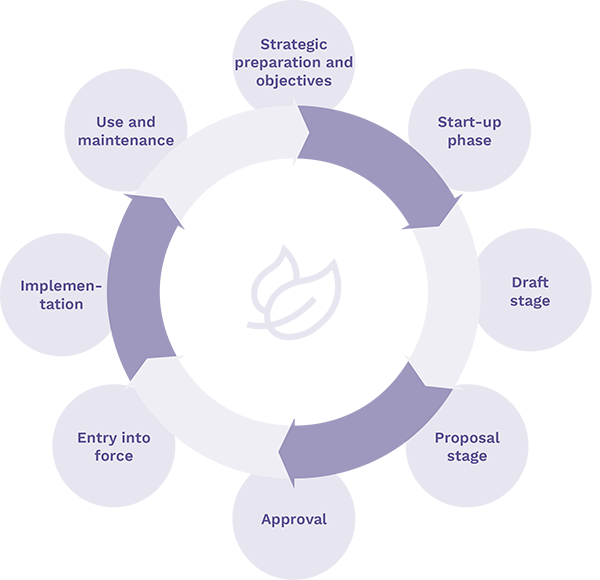The development of nature in a sustainable and smart area was considered in the project workshop alongside the themes of mobility and energy. Green infrastructure refers to a strategically planned network of green spaces, including a water system.
Blue-green infrastructure is conceived as a regional ecosystem, and the challenge in co-creation is how to communicate the development objectives throughout the planning process and the lifecycle of the area. A key challenge is also to map and describe the baseline knowledge and to measure and verify the development of sustainability.
The results of this work were summarised in an article, and the diagram below shows the main stages of the co-creation process.

Co-creation process
- Identification of the actors involved in the design, construction and maintenance of blue-green infrastructure in the region as an initial market dialogue and internal work within the city.
- Defining the roles and cost responsibilities ofprivate and publicactorsin the implementation of blue-green infrastructure in the region. Implementation and maintenance models.
- Expert survey and description of the state of nature, values, flows and potential for ecosystem services, and identification of special sites and places of interest in the local natural environment through surveys.
- Defining, together with the market dialogue consortium, the target level of solutions for green and blue-green infrastructure and their readiness and maintenance in light of the municipal and national strategic objectives. Translating objectives into a clear vision and identifying needs in the form of a plan.
- Communicating the vision for blue-green infrastructure and organising a comment and development round on the project website. Opening up a permanent dialogue with all stakeholders.
- Revision of the target level of blue-green infrastructure based on feedback and in relation to other needs of the plan. Agreeing and describing the main principles of the content. Review of the solutions.

7. Establishing a commitment and performance indicators for the implementation of blue-green infrastructure.Feedback possibility for market operators and others interested in the development of the area.
8. Refining, innovating and specifying solutions for individual sites (plot, park, street) through planning, competitions, etc. Description of the level of maintenance and actors involved and verification of the effectiveness of solutions in relation to indicators (net biodiversity gain, CO2, cooling, sustainable stormwater management, functional diversity, food/crop, etc.) + interaction.
9. Reflecting on and evaluating the contractor’s development ideas. Creating a maintenance target and contract documents.
10. Specification of the level and means of maintenance through a negotiated procedure with the selected maintenance contractor for the area/site and commitment to the substantive objectives.
11. Residents’ functional and maintenance start-up with workshops involving the maintenance contractor or maintenance company.
12. Development of sites and measurement of the implementation of regional targets through annual reviews by landowners and the city. Possible corrective measures.
